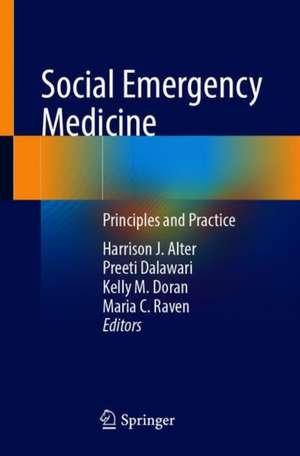Social Emergency Medicine: Principles and Practice
Editat de Harrison J. Alter, Preeti Dalawari, Kelly M. Doran, Maria C. Ravenen Limba Engleză Paperback – 7 sep 2021
This book includes foundational chapters on the salience of racism, gender and gender identity, immigration, language and literacy, and neighborhood to emergency care. It provides readers with knowledge and resources to assess and assist emergency department patients with social needs including but not limited to housing, food, economic opportunity, and transportation. Core emergency medicine content areas including violence and substance use are covered uniquely through the lens of Social Emergency Medicine. Each chapter provides background and research, implications and recommendations for practice from the bedside to the hospital/healthcare system and beyond, and case studies for teaching. Social Emergency Medicine: Principles and Practice is an essential resource for physicians and physician assistants, residents, medical students, nurses and nurse practitioners, social workers, hospital administrators, and other professionals who recognize that high-quality emergency care extends beyond the ambulance bay.
Preț: 673.16 lei
Preț vechi: 708.58 lei
-5% Nou
Puncte Express: 1010
Preț estimativ în valută:
128.81€ • 134.85$ • 106.58£
128.81€ • 134.85$ • 106.58£
Carte tipărită la comandă
Livrare economică 01-07 aprilie
Preluare comenzi: 021 569.72.76
Specificații
ISBN-13: 9783030656713
ISBN-10: 3030656713
Pagini: 375
Ilustrații: XVII, 375 p. 5 illus., 3 illus. in color.
Dimensiuni: 155 x 235 mm
Greutate: 0.74 kg
Ediția:1st ed. 2021
Editura: Springer International Publishing
Colecția Springer
Locul publicării:Cham, Switzerland
ISBN-10: 3030656713
Pagini: 375
Ilustrații: XVII, 375 p. 5 illus., 3 illus. in color.
Dimensiuni: 155 x 235 mm
Greutate: 0.74 kg
Ediția:1st ed. 2021
Editura: Springer International Publishing
Colecția Springer
Locul publicării:Cham, Switzerland
Cuprins
1. History of Social Emergency Medicine.- 2. Public Health, Population Health, and Health Disparities.- 3. Race and Racism.- 4. Gender and Sexual Identity.- 5. Immigration.- 6. Language and Literacy.- 7. Access to Care.- 8. Frequent Emergency Department Use: A Social Emergency Medicine Perspective.- 9. Substance Use: A Social Emergency Medicine Perspective.- 10. Education and Employment.- 11. Financial Insecurity.- 12. Food Insecurity.- 13. Homelessness.- 14. Housing Instability and Quality.- 15. Transportation.- 16. Legal Needs.- 17. Neighborhoods and the Built Environment.- 18. Violence.- 19. Firearm Injury.- 20. Incarceration.- 21. Human Trafficking.
Notă biografică
Harrison J. Alter, MD, MS
Vice Chair for Research, Department of Emergency Medicine
Highland Hospital - Alameda Health System
Clinical Professor, Department of Emergency Medicine
University of California-San Francisco
Oakland, CA
Preeti Dalawari, MD, MSPH
Professor and Research Director, Division of Emergency Medicine
Saint Louis University School of Medicine
Associate Professor, Saint Louis Center for Outcomes Research
Saint Louis, MO
Kelly M. Doran, MD, MHS
Assistant Professor, Ronald O. Perelman Department of Emergency Medicine and Department of Population Health
New York University School of Medicine
New York, NY
Maria C. Raven, MD, MPH, MSc
Associate Professor
Department of Emergency Medicine
University of California, San Francisco
Adjunct Faculty, UCSF Institute for Health Policy Studies
San Francisco, CA
Textul de pe ultima copertă
Social Emergency Medicine incorporates consideration of patients’ social needs and larger structural context into the practice of emergency care and related research. In doing so, the field explores the interplay of social forces and the emergency care system as they influence the well-being of individual patients and the broader community. Social Emergency Medicine recognizes that in many cases typical fixes such as prescriptions and follow-up visits are not enough; the need for housing, a safe neighborhood in which to exercise or socialize, or access to healthy food must be identified and addressed before patients’ health can be restored. While interest in the subject is growing rapidly, the field of Social Emergency Medicine to date has lacked a foundational text – a gap this book seeks to fill.
This book includes foundational chapters on the salience of racism, gender and gender identity, immigration, language and literacy, and neighborhood to emergency care. It provides readers with knowledge and resources to assess and assist emergency department patients with social needs including but not limited to housing, food, economic opportunity, and transportation. Core emergency medicine content areas including violence and substance use are covered uniquely through the lens of Social Emergency Medicine. Each chapter provides background and research, implications and recommendations for practice from the bedside to the hospital/healthcare system and beyond, and case studies for teaching. Social Emergency Medicine: Principles and Practice is an essential resource for physicians and physician assistants, residents, medical students, nurses and nurse practitioners, social workers, hospital administrators, and other professionals who recognize that high-quality emergency care extends beyond the ambulance bay.
This book includes foundational chapters on the salience of racism, gender and gender identity, immigration, language and literacy, and neighborhood to emergency care. It provides readers with knowledge and resources to assess and assist emergency department patients with social needs including but not limited to housing, food, economic opportunity, and transportation. Core emergency medicine content areas including violence and substance use are covered uniquely through the lens of Social Emergency Medicine. Each chapter provides background and research, implications and recommendations for practice from the bedside to the hospital/healthcare system and beyond, and case studies for teaching. Social Emergency Medicine: Principles and Practice is an essential resource for physicians and physician assistants, residents, medical students, nurses and nurse practitioners, social workers, hospital administrators, and other professionals who recognize that high-quality emergency care extends beyond the ambulance bay.
Caracteristici
Focuses on everyday changes that emergency practitioners can make in their practice Discusses housing, food, community safety/violence, economic opportunity, education, and more Includes specific tools that can be used for educating residents and students Brings together previously disparate clinical, research, education, and policy information
